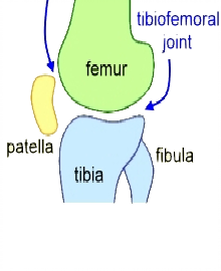Squats, Lunges, and the more advanced Jump Squats are all exercises that have a lot in common. They are all highly functional exercises and all very popular and beneficial in an exercise program (when done correctly). In all of these exercises the knee is flexing (bending) and then extending (straightening) we also get a bend and extend action happening at the ankle and the hip. When this happens we are putting force through the joint. It is this idea of force through a joint that we are focusing on today.
A study by Cleaver, Goodwin and Bull in 2012 focused on the internal joint force of the knee experienced when jumping and landing. They found that through this action the Tibiofemoral Joint (knee joint) experienced a peak loading in the range of 6.9-9 times body weight and the ankle joint a loading of 8.9 to 10 times body weight.
Now converting this into some basic numbers. If an exerciser weighs 100kg, according to the above figures their knee is experiencing a load of 690-900kg and the ankle a load of 890-1000kg. As always I will now highlight the functional aspect of this concept. When the body is functioning well with all muscles working exactly as they should and all working in perfect balance, the body should have no issues working with these forces. However if there is a structural misalignment or issues with the functioning of muscles these forces could be an issue in time. Consider someone with a Genu Valgum (a condition where the knees, angle in towards one another. With this condition the force is distributed through the knee in a way that is not ideal and can lead to serious injury and long term knee issues. Now consider repeating an exercise like jump squats and putting a huge amount of force through a knee that is structurally vulnerable and ill equipped to deal with that force. It is inevitably going to lead to problems and some serious pain at some point. Alternatively consider someone considerably over weight performing high intensity training involving repetitive jumping. The joints are naturally going to be having to deal with more force moving through them then they were ever designed to. Again, pain and injury is extremely likely and in my opinion not worth the risk.
As always it is important to consider if the exercises you are doing are the best exercises for you. If you are regularly performing high intensity exercises such as jump squats, burpees etc, where a lot of force is going through your joints, it may be a good idea to have a health professional look at your technique to ensure you are not setting yourself up for injury later. There are endless ways you can improve your fitness without putting your body through high levels of unnecessary and dangerous stress. Work hard but make sure you are also working smart. If you are looking to get into fitness and are unsure where to start check out functionalforlife.com.au or contact us through Facebook. Happy Training!
Warning: The training and instructional content contained on this website should be taken as information and not medical advice. Please consult your health professional before attempting these exercises.
References:
1. Cleather, D Goodwin, J Bull, A 2012, Hip and knee joint loading during vertical jumping and push jerking, Europe PubMed Central, available from https://www.ncbi.nlm.nih.gov/pmc/articles/PMC3966561/, accessed September 5 2017
2. PhD PT, 2008, Joint structure of the knee complex, available from http://www.pt.ntu.edu.tw/hmchai/Kinesiology/KINlower/Knee.files/KneeStructure.htm , accessed on September 5th 2017







